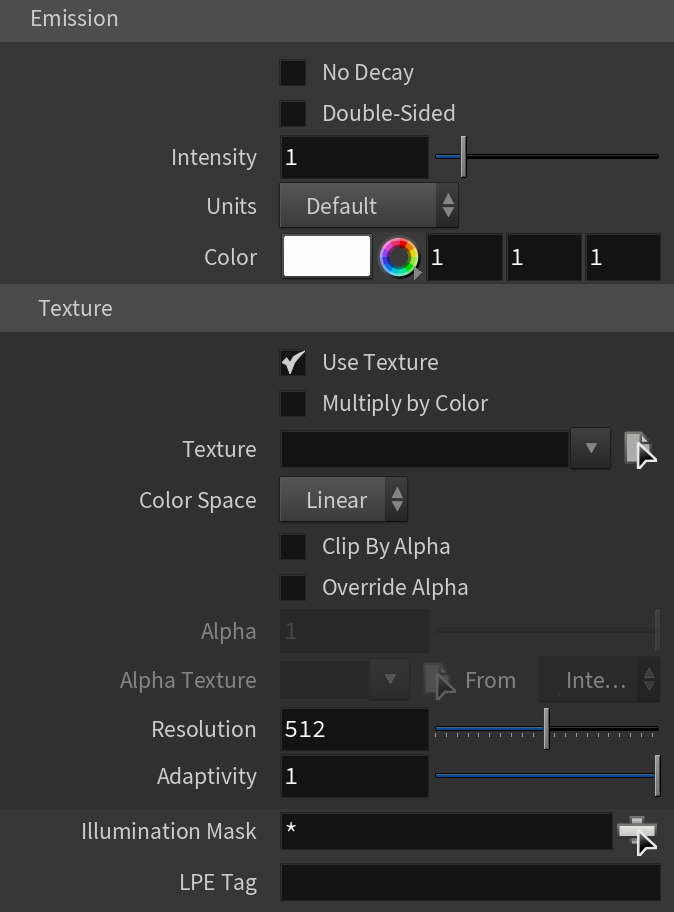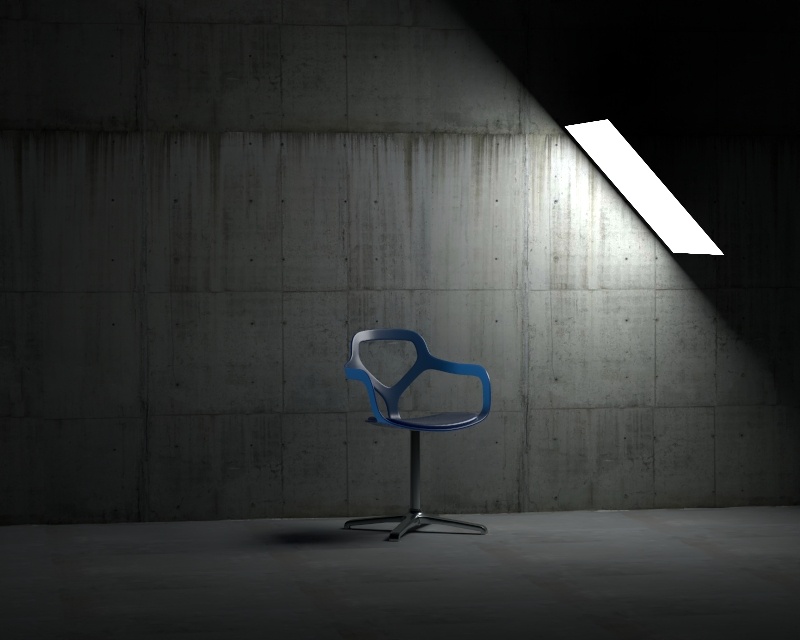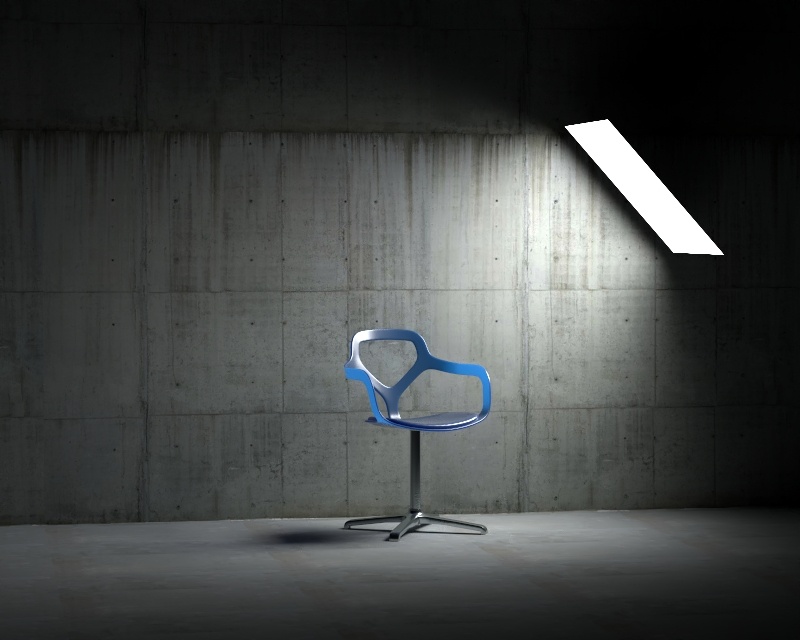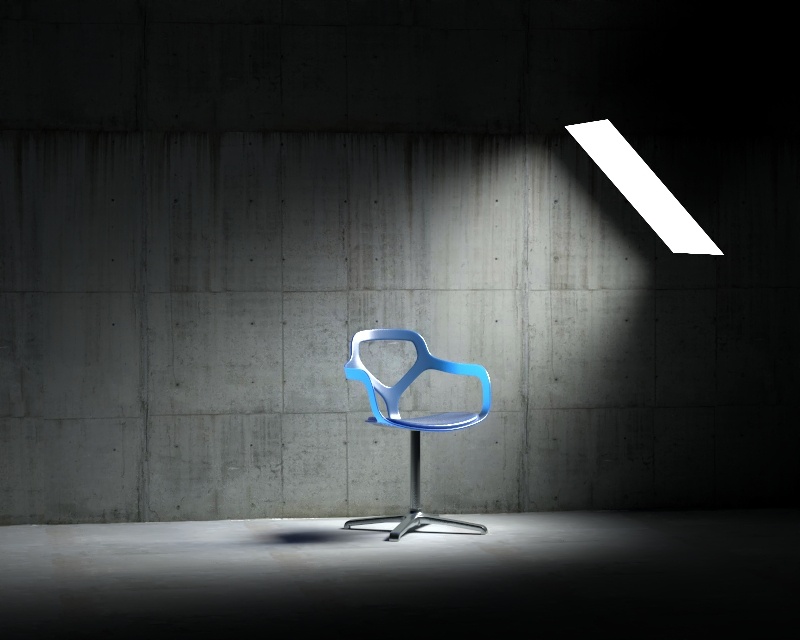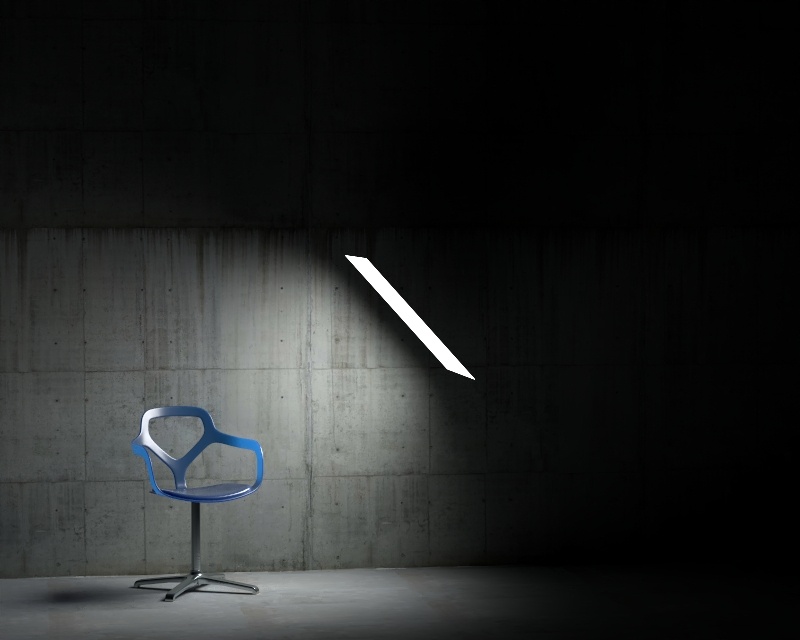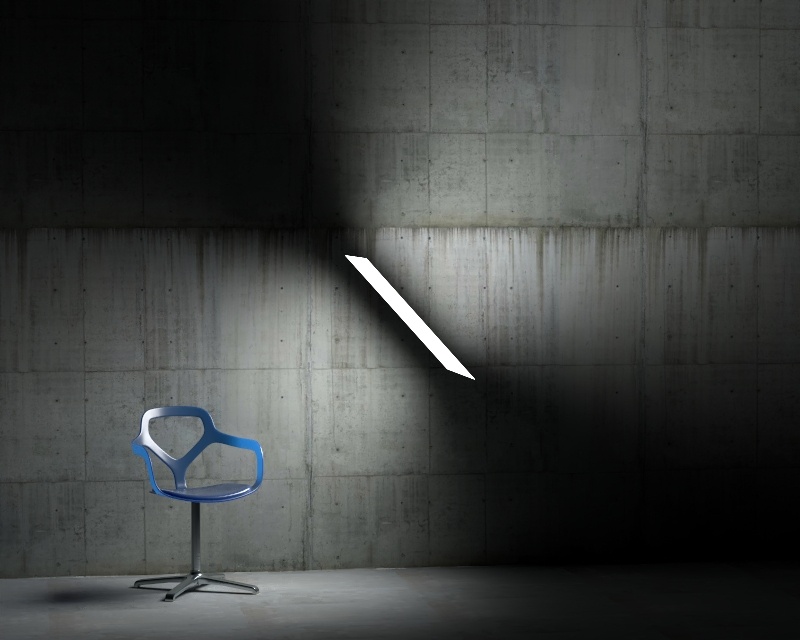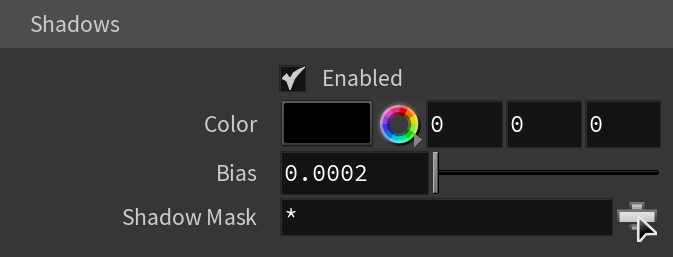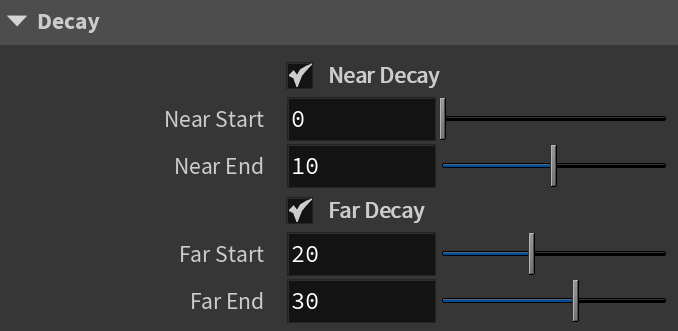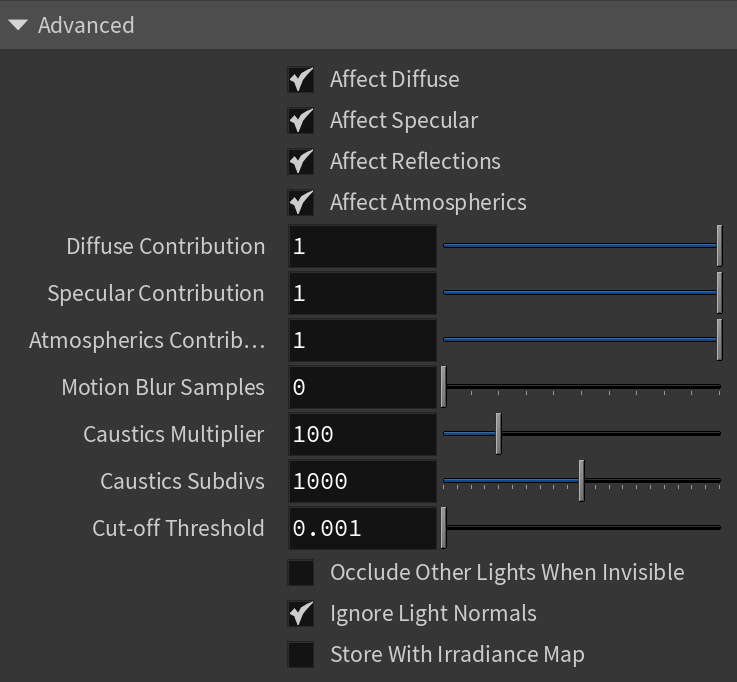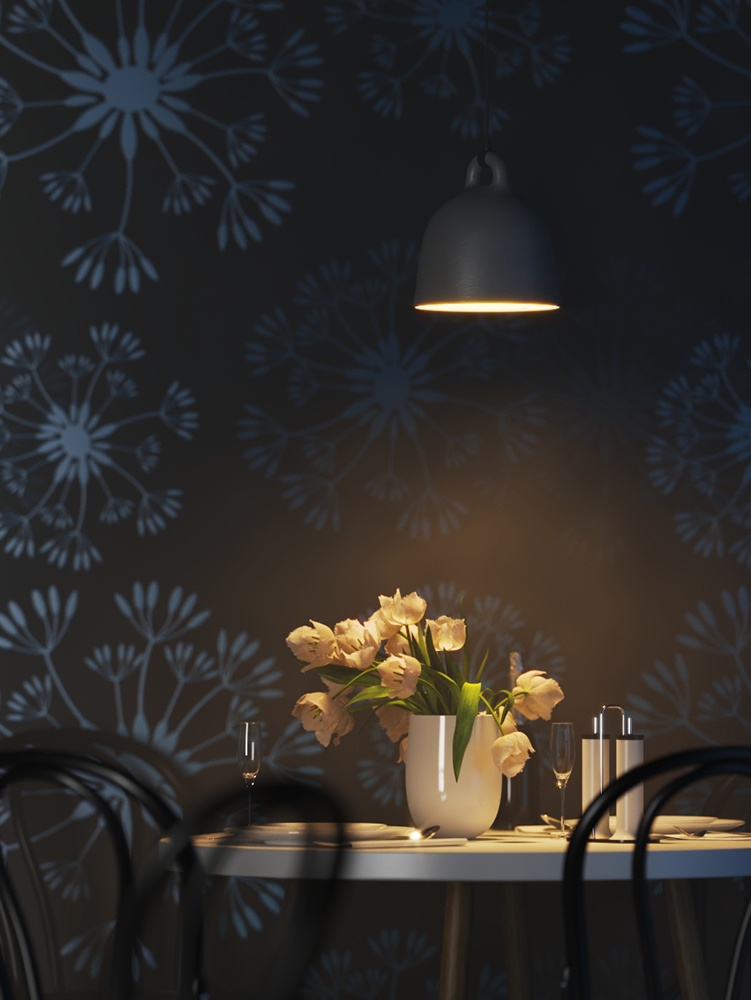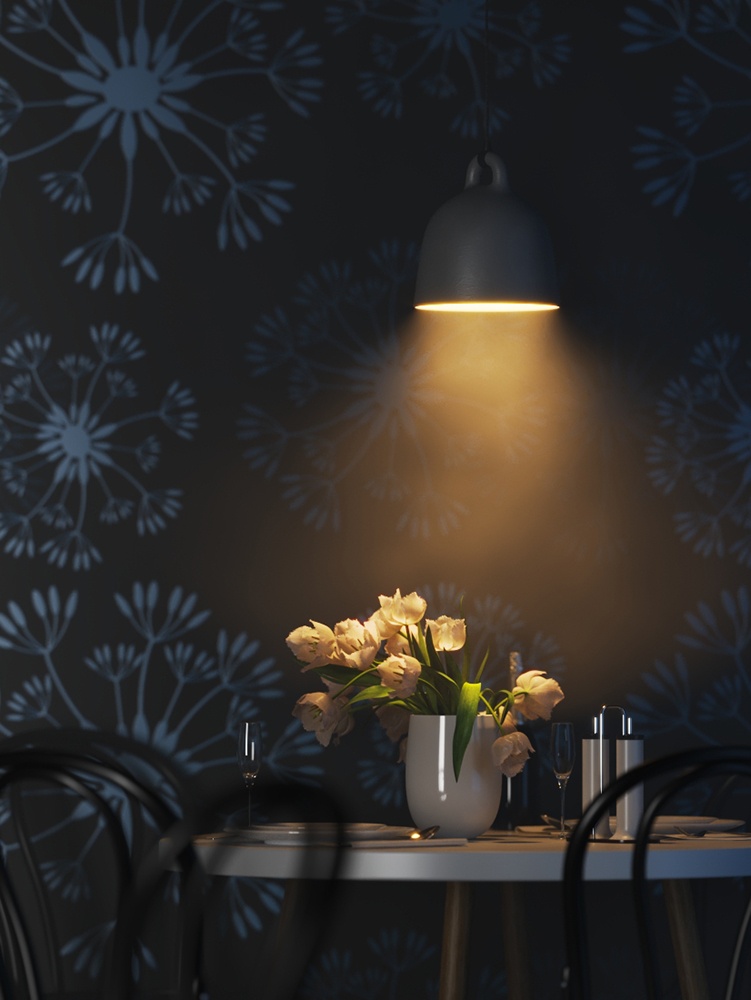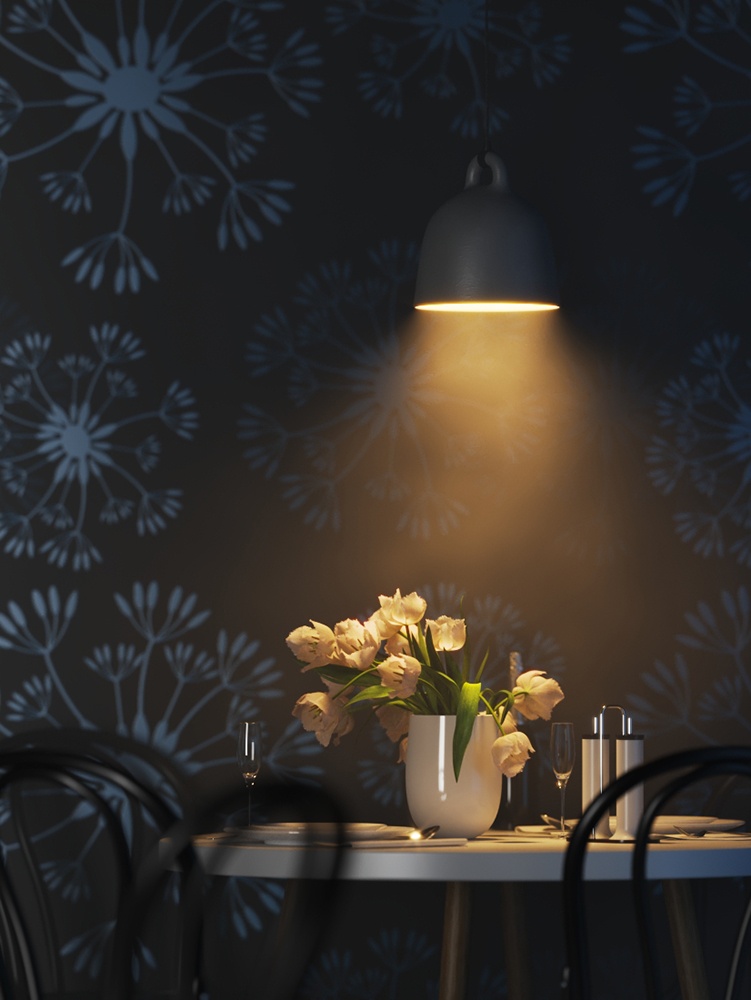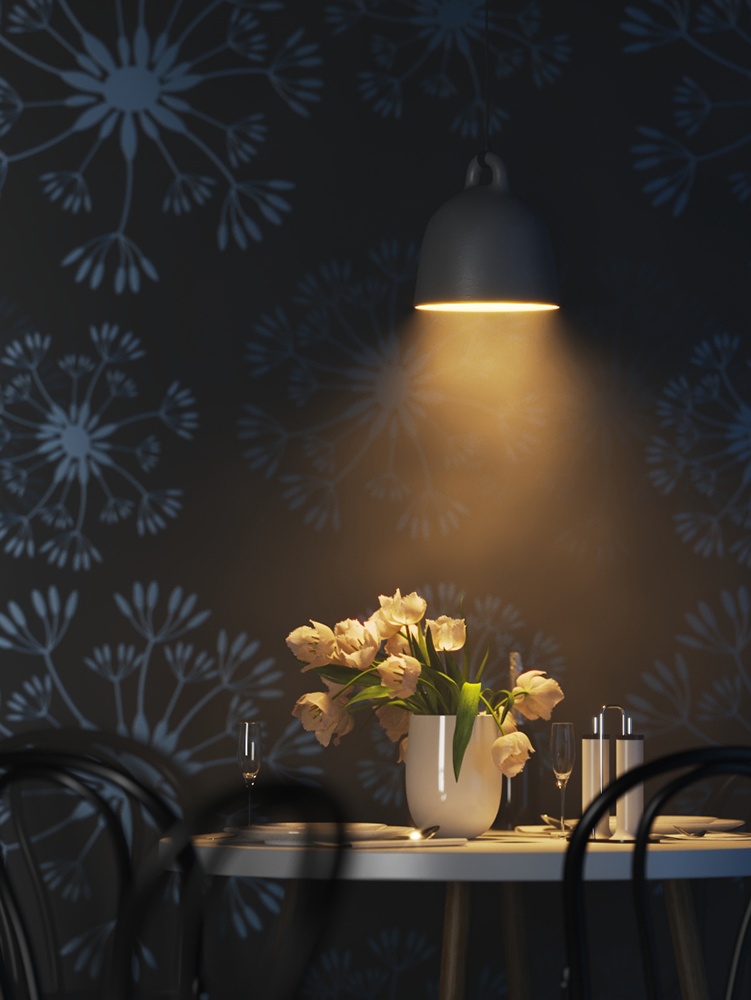This page provides information on the V-Ray Rectangle Light, also known as an Area Light.
Overview
The V-Ray Rectangle Light or Area Light is a planar light source. The light shape can be set as a rectangle or a circular disk.
Shape
Enabled – Turns the light on and off.
Invisible – Controls whether the shape of the Rectangle Light source is visible in the resulting render. When disabled, the source light is rendered in the current light color, otherwise the light source itself is not visible in the scene.
Note: This parameter only affects the visibility of the light when seen directly by the camera or through refractions. The visibility of the light with respect to reflections is controlled by the Affect Specular and Affect Reflections options.
Is Disc – When enabled, the light is in the shape of a planar disc instead of a rectangle.
Width – Determines the width of the light measured in scene units.
Height – Determines the height of the light measured in scene units.
Directional – When this value is 0, the light is spread out equally in all directions. Increasing this value makes the light beam more narrow and concentrates it in one direction. For illustration, see the Directionality example.
Directional Preview Length – Specifies the length of the cone used to preview the Directional parameter in the viewport. This parameter is available only when Directional is greater than 0.
Directional Strength – Controls the strength of the directional distribution.
Object ID – Specifies an integer object ID to the light.
Emission
No Decay – When enabled, the intensity of the light has no fall off with distance. Normally the light intensity is inversely proportional to the square of the distance from the light (surfaces that are farther from the light are darker than surfaces which are closer to the light). See the Sphere Light page for an example of this property.
Double-Sided – Controls whether light is emitted from both sides of each face. See the Double Sided example below of this property.
Intensity – Multiplier for the light strength; this is also the light intensity in the units set by the Units parameter.
Units – Specifies the light units. Using correct units is essential when using the V-Ray Physical Camera. The light automatically takes the scene's unit scale into consideration to produce the correct result for the scale you are working with. The possible values are:
Default – The color and multiplier directly determine the visible color of the light without any conversion. The light surface appears with the given color in the final image when seen directly by the camera (assuming there is no color mapping involved).
Lumens – Total emitted visible light power measured in lumens. When this setting is used, the intensity of the light does not depend on its size. A typical 100W electric bulb emits about 1500 lumens of light.
Lm/m/m/sr – Visible light surface power measured in lumens per square meter per steradian. When this setting is used, the intensity of the light depends on its size.
Watts – Total emitted visible light power measured in watts. When using this setting, the intensity of the light does not depend on its size. Keep in mind that this is not the same as the electric power consumed by a light bulb for example. A typical 100W light bulb only emits between 2 and 3 watts as visible light.
W/m/m/sr – Visible light surface power measured in watts per square meter per steradian. When this setting is used, the intensity of the light depends on its size.
Color – Specifies the color of the Rectangle Light.
Texture
Use Texture – Allows the light to use a texture for its surface. If there are surfaces which are close to a texture-mapped light, it is best to have GI enabled. This allows V-Ray to use combined direct and indirect sampling for the light, reducing the noise for surfaces close to the light.
Multiply by Color – When enabled, the Rectangle texture is multiplied by color.
Texture – Specifies a texture to use with the light.
Color Space – Selects the color space.
Linear
sRGB
Clip By Alpha – When enabled, clips the texture based on the Alpha.
Override Alpha – When enabled, replaces the Alpha of the loaded file with the Alpha of another file.
Alpha – Regulates the transparency of the Alpha.
Alpha Texture – Selects a Texture Alpha.
From – Replaces the Alpha of the texture with another or uses Intensity.
Resolution – Specifies the resolution at which the texture is sampled when the Texture Adaptivity option is enabled.
Adaptivity – V-Ray adjusts the number of samples taken for different parts of the texture depending on their brightness. A value of 0.0 specifies no adaptivity; a value of 1.0 specifies full adaptivity.
Illumination Mask – Specifies an additional illumination mask used to force object illumination.
LPE Tag – Allows you to specify a string tag that can be used in a Light Path Expression to isolate the contribution from this light. See the Advanced Light Path Expressions page for more information.
Example: Directionality
This example demonstrates how the light changes when Directional value is changed, ranging from 0 to 1. When the value is closer to 1, the light is more focused towards one point, while when the value is closer to 0, the light spreads to all sides.
Example: Double-Sided
This example demonstrates the behavior of the light when Double-Sided option is enabled and disabled. When the Double-Sided option is enabled, light is emitted from the two sides of the Rectangle light body.
Shadows
Enabled – When enabled, the light casts shadows. Disable this option to turn off shadows for the light.
Color – Controls the color of shadows for this light. Note that anything different from black is not physically correct.
Bias – Moves the shadow toward or away from the shadow-casting object (or objects). Higher values move the shadow toward the object(s) while lower values move it away. If this value is too extreme, shadows can "leak" through places they shouldn't or "detach" from an object. Other effects from extreme values include moire patterns, out-of-place dark areas on surfaces, and shadows not appearing at all in the rendering.
Shadow Mask – Specifies objects that cast shadows when light is directed at them.
Textures
Emission Color – Specifies the color of the light rays and of the light source itself when visible in renderings.
Shadow Color – Specifies the color of the shadows produced by the light.
Decay
The Decay parameters determine how the light fades in and out. The Near Decay determines how light fades in. The light isn't at its maximum value at its source, but instead gradually increases until it reaches the Near End. The Far Decay determines how light fades out. The light isn't at its maximum value at its end, but instead gradually decreases after the Far Start.
Decay option is useful for creating hotspots or controlling the length of a "God Rays" effect created with Environment Fog.
Near Decay – Toggles near decay on and off. See the examples below for more information.
Near Start – Determines where the fade in starts. Anything before this point is rendered dark.
Near End – Determines where the fade in ends. After this threshold, the light is at its full value.
Far Decay – Toggles far decay on and off. See the examples below for more information.
Far Start – Determines where the fade off starts.
Far End – Determines where the light reaches a value of 0, i.e. completely fades off.
Advanced
Affect Diffuse – Determines whether the light affects the diffuse properties of the materials.
Affect Specular – Determines whether the light affects the specular of the materials. This means glossy reflections.
Affect Reflections – Determines whether the light appears in reflections of materials, for both perfect and glossy reflections.
Affect Atmospherics – Determines whether the light influences the atmospheric effects in the scene.
Diffuse Contribution – When Affect Diffuse is enabled, specifies a multiplier for the effect of the light on the diffuse component.
Specular Contribution – When Affect Specular is enabled, specifies a multiplier for the effect of the light on the specular component.
Atmospherics Contribution – When Affect Atmospherics is enabled, this value determines the amount of involvement.
Motion Blur Samples – Specifies the number of samples used to sample the light for motion blur.
Caustics Multiplier – Specifies a multiplier for the generated caustics by the selected object. Note that this multiplier is cumulative - it does not override the multiplier in the Caustics Tab of the V-Ray Render Settings.
Caustics Subdivs – Only used when calculating Caustics. Lower values mean more noisy results, but render faster. Higher values produce smoother results but take more time.
Cut-off Threshold – Specifies a threshold for the light intensity, below which the light is not computed. This can be useful in scenes with many lights, where you want to limit the effect of the lights to some distance around them. Larger values cut away more of the light; lower values make the light range larger. When this value is 0.0, the light is calculated for all surfaces.
Occlude Other Lights When Visible – Controls the behavior of invisible lights in relation to other light sources. When enabled, the light blocks the lighting from other lights as if it's visible. Also in reflections the light behaves as it's visible and occludes other lights. When disabled, the light is transparent for other lights and does not occlude them. This option doesn't affect visible lights (as they always occlude other lights) and dome lights (which are always additive).
Ignore Light Normals – Usually, the surface of the source emits light equally in all directions. When this option is disabled, more light is emitted in the direction of the source surface normal.
Store With Irradiance Map – When enabled and GI calculation is set to Irradiance map, V-Ray calculates the effects of the V-Ray Rectangle Light and stores them in the irradiance map. The result is that the irradiance map is computed more slowly but the rendering takes less time. The irradiance map can also be saved for later use.
This example shows the variances achieved by changing the Near Start parameters only. This example shows the variances achieved by changing the Near End parameters only. This example shows the variances achieved by changing the Far Start parameters only. This example shows the variances achieved by changing the Far End parameters only. This example shows some artistic lighting results achieved by using both Near and Far decay options.
Example: Decay Near Start
Example: Decay Near End
Example: Decay Far Start
Example: Decay Far End
Example: Near and Far Decay
Notes
- Is Disc mode supports non-uniform scaling.

